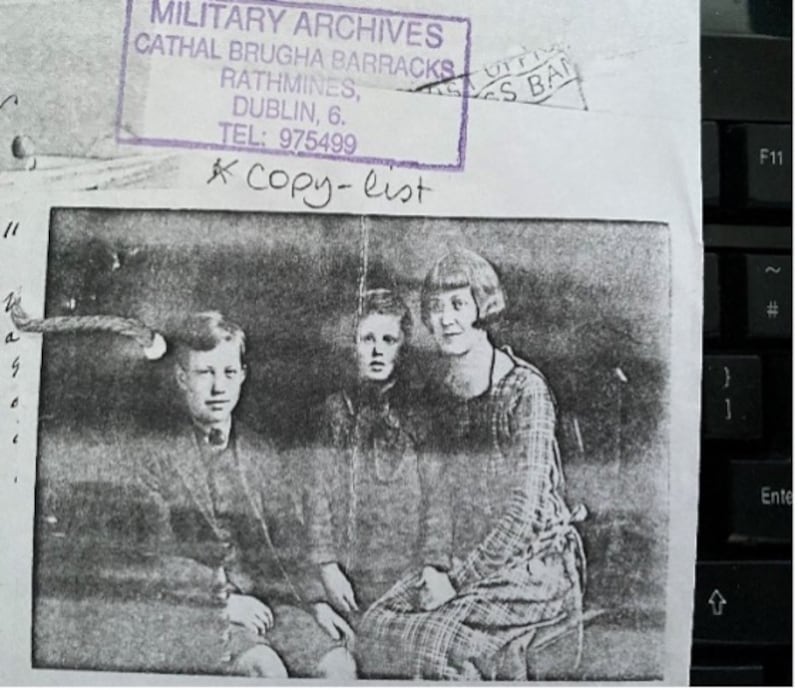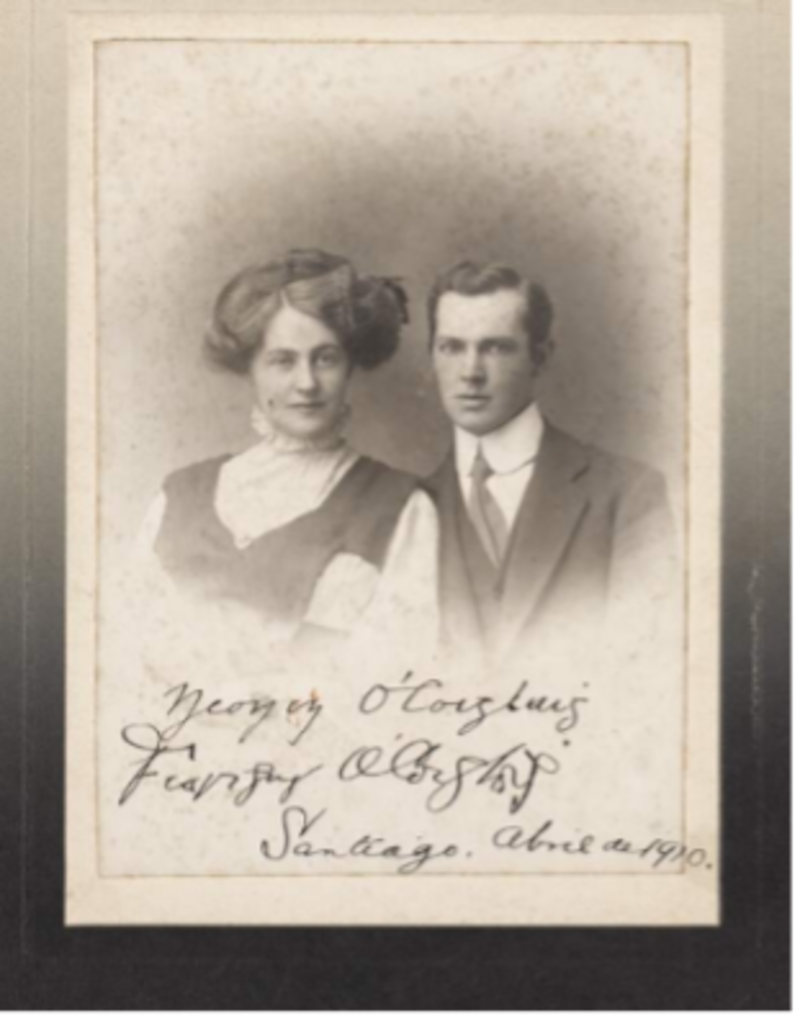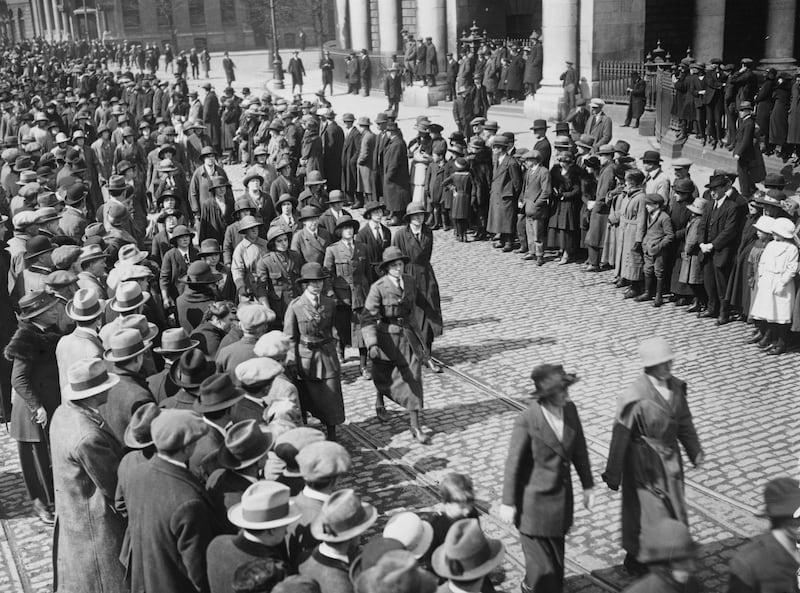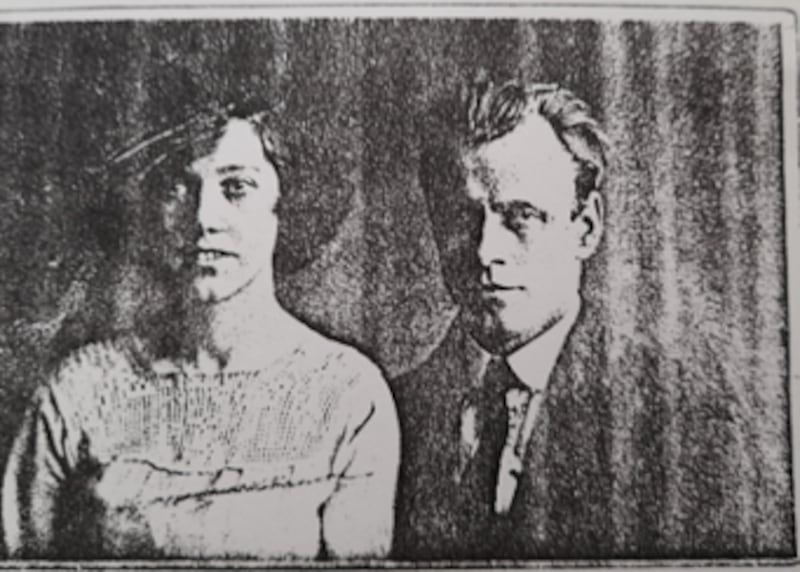The Military Archives has a series of folders called the “captured papers” which includes material appropriated during raids and taken in searches of prisoners – including women political prisoners – during the Civil War. Lot 39 contains a photograph of a woman and two children. On the reverse of the picture is a message: “I went up several times to Kilmainham, but felt so horribly depressed that I had to give up – you can’t image what we felt outside about ye. I was also at the joy gates a few times.”
[ Read the complete Century: 1923 Birth of a Nation seriesOpens in new window ]

A survey of prison records, autograph books and other files has established a list of 554 women prisoners in 1923. Women were held in prisons and barracks all around the State but most were held in Dublin’s Mountjoy Jail – here described as “the joy” – Kilmainham Gaol and, later, the former workhouse of the North Dublin Union in Cabra, which was made a place of detention.
During the Civil War prisoners were not allowed to have visitors so people gathered outside the jail shouting up messages to those inside and passing on information from them. A painting by Jack B Yeats, Communicating with Prisoners, now in The Niland Collection at The Model in Sligo, shows people gathered outside Kilmainham Gaol.
Frightening
It was a frightening time: there were executions of prisoners taking place in jails and barracks all over the country. No women were executed but during 1923 but there was always the fear that someone would be killed. There were also hunger strikes and women became ill in prison from the damp conditions. A number of women died in the following years and families blamed their imprisonment for their early deaths.
An organisation called the Women’s Prisoners’ Defence League was formed by Maud Gonne MacBride and Charlotte Despard to help people get information on the whereabouts of men and women who were arrested.
The aforementioned photograph forms part of the material confiscated from prisoners in the North Dublin Union. On the files it says it was “captured” in the camp on August 25th, 1923. The sender identified herself as Nóinín (the Irish for Daisy). The republican and writer Lily O’Brennan documents that Daisy Cogley was released from prison due to ill health; like so many of the women, she did not do well in prison – her ill health was due to separation from her children.

Fashionable
Noínín, with her fashionable bobbed hair, was in fact a Frenchwoman who had married in Chile 13 years before. A photograph of her with her husband Fred is in the National Library of Ireland – dated April 1910, you can just make out, in cursive handwriting, their names written in Irish and the place, Santiago. Born in Paris to an Irish mother, Joanna Mary Bannard, she was a singer and actress who had studied at the Sorbonne. Later, she was a co-founder of Dublin’s Gate Theatre.

In another file in the “captured papers” is a bundle of papers with names and addresses. There are about 40 sheets, all collected by military guards from prisoners. They were looking for information on the women detained; some gave false details such as names and addresses.
There were many raids on the homes of those who were opposed to the new Irish Free State. Letters and diaries of the time tell of what was happening outside the prison. There were raids called “sit down” raids, where authorities came to houses (men and sometimes women) and waited, sometimes for days, if they were looking for people on the run. There were many accounts of raids where all the food in the house was destroyed, clothes ripped and furniture broken. In houses of families of some of the 1916 leaders, photographs were destroyed and personal mementos taken.
‘Suspect’ women
Those arrested were called “suspect women”. In September 1922 the provisional government took the decision to arrest any women who were “actively assisting” irregulars (a reference to anti-Treaty forces). Many were women who had been providing intelligence and support which had been essential during the War of Independence.
Daisy was one of the first women to be arrested, in November 1922 in Sinn Féin offices on Suffolk Street. From then on, she remained with the group of women calling themselves ‘Suffolk Street’, another of whom was Teresa ‘Tessie’ O’Connell from Kerry. Among the prisoners who joined them were Nell Humphries (sister of The O’Rahilly, killed in 1916) and her daughter Sighle, Dorothy Macardle (an author who wrote the short story collection Earth-Bound while in prison) and Mary MacSwiney, TD (first elected in May 1921 and re-elected in June 1922).
While Daisy was in prison, Mary MacSwiney was on hunger strike in protest. International attention was focused on her as sister of Terence MacSwiney, lord mayor of Cork, who had died in Brixton Prison in 1920 after 74 days on hunger strike. On 21 November 1922 her sister Annie joined her on hunger strike outside the prison gates to highlight her sister’s protest inside. Newspaper reporters came to see her and she was photographed in her bed erected at the prison gates as she too went without food.

Sixteen republican women, including Daisy, signed their names to a message to the people of Ireland pleading for Mary to be released from prison: “What effort, what danger, what sacrifice is it not worth, to save for Ireland so noble a life as this?” Mary was released; however, she would be back in prison the following year. This time Annie was a prisoner as well and they would go back on hunger strike.
The Night Owls were the younger prisoners who like to stay up late, much to the chagrin of the older prisoners. One fragment of ephemera is for a céilí dance they hosted asking those to attend to wear red and black
Censored
Female internees were not allowed to have visitors and their correspondence was limited. Many found their imprisonment lonely and isolating. Later they were allowed to have parcels and family and friends sent in food. Although one prisoner got a letter describing her birthday cake, she had to enjoy the description of it because the cake was not delivered.
It was decided that the disused Kilmainham Gaol be “fitted up” as a prison for “suspect women”. The General Prisons Board of Ireland thought that it could house 100 women. Cells were furnished with a table, iron bedstead and a stove. As well as prison staff, what were described in official documents as “ordinary” female convicts were selected and brought from Mountjoy to cook and clean and work the furnace for baths. The inmates were political prisoners, described as “no ordinary women” by those who had arrested them.
Military guard
A military guard was posted outside the prison and it was advised by the prisons board that they would assist, if required, within the prison. A woman doctor was appointed. Dr Brigid Lyons had been imprisoned in Kilmainham for her participation in the 1916 Rising – now she was looking after her former comrades. Newly graduated as a doctor in 1922, Lyons joined the medical service of the Irish Free State army at the rank of lieutenant.
According to official records, there were 185 prisoners in the whitewashed cells of ‘A’ compound in Kilmainham Gaol n March 8th, 1923. Unofficial records suggest that the number was much larger. In February Annie MacSwiney recorded “nearly 300 women” in Kilmainham, “ranging in age from 14 to close on 70”.

The number of prisoners continued to increase. Under the Restoration of Order in Ireland Act, women deported from London, Liverpool and Glasgow were now among the prisoners. They included Eileen Barrett, Aggie Sheehan, Sorcha MacDermott, Hannah ‘Pidge’ Duggan, Lizzie Marrin, Mollie Duff and Mary Nelson. A number of women from Kerry were transported on a boat normally used to bring cattle being to markets in Dublin.
On April 10th, 1923, Mary MacSwiney was rearrested along with fellow TD Kate O’Callaghan. They had been on their way to Liam Lynch’s funeral. Hunger strikes would continue throughout 1923, sometimes for infringements on prisoners’ rights but mostly for release.
News came to prisoners of deaths outside the prison. Annie Moore heard of the execution of her brother Brian and her fiance Patrick Nolan. Margaret Buckley, who wrote of her jail experiences in Jangle of the Keys, published by J Duffy & Co in 1938, described her as “an inconsolable-looking girl”.
‘Republican sisterhood’
The women and girls took comfort in sharing cells. Cellmates grouped together as ‘Barry’s Own’, ‘Devil May Cares’, ‘The Flying Squad’, ‘The Invincibles’, ‘The Snipers’, ‘The Republican Sisterhood’, ‘The Barbarians’ and ‘The Night Owls’. (The Night Owls were the younger prisoners who like to stay up late, much to the chagrin of the older prisoners; one fragment of ephemera is for a céilí dance they hosted asking those to attend to wear red and black). The prisoners were not locked into their cells during the day; they were allowed to move around the wing they occupied.
The senior members of Cumann na mBan formed a prisoners’ council with commanding officers, quartermasters and adjutants. These members made depositions to the governor on behalf of prisoners. The prisoners’ council arranged classes and other activities such as cards, concerts and sports to pass the time.
In late April some 270 women were taken from Kilmainham and Mountjoy to specially arranged dormitories in the former workhouse of the North Dublin Union. As some women were on hunger strike, the prisoners resisted being removed, using the tactics of the militant suffragettes of linking arms in rows of four, as they feared what would happen to those who remained behind. The official report stated that this removal led to “destruction of cell bell fittings, window sashes, windows, woodwork”.
In Mountjoy, Maura Deegan hit a man who tried to move her with a bucket of slops and, according to her fellow internees, this was followed by “a row”. Sorcha MacDermott was beaten with her own shoe. As a result of her injuries, she was deemed “too weak” to be transferred.
After May the Ministry of Home Affairs decided that a certain “class of females” would return to Kilmainham Gaol to break the command structure in the North Dublin Union. Margaret Buckley, Úna Gordon, Bridie O’Mullane, Eileen McGrane and Nell and Sighle Humphreys found themselves once again in Kilmainham.
Arrests continued in the summer of 1923. In an effort of maintain morale, the fancy-dress parties, céilí dances and a variety of sporting activities continued in the jail, but the grim reality of the Civil War was ever present.
On September 29th, 1923 all the women prisoners were taken back to North Dublin Union. On October 10th 50 women joined a mass hunger strike to bring about a general release. One of the last prisoners to be arrested on November 20th, 1923 was Constance Markievicz. She joined the hunger strike in the North Dublin Union just three days before it was called off.
News began to circulate that the remaining prisoners would be released by Christmas. The prisoners received little support outside the prisons; the general public wanted peace. The final women prisoners were released in December 1923. Later, speaking of this time to Uinseann MacEoin, Sighle Humphries said: “We were flattened ... The tinted trappings of our fight were hanging like rags about us.”
Dr Sinéad McCoole is a historian, author and curator









